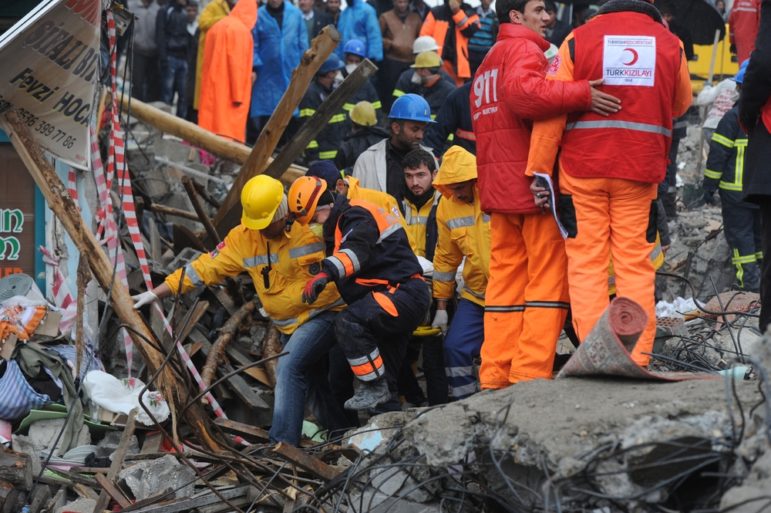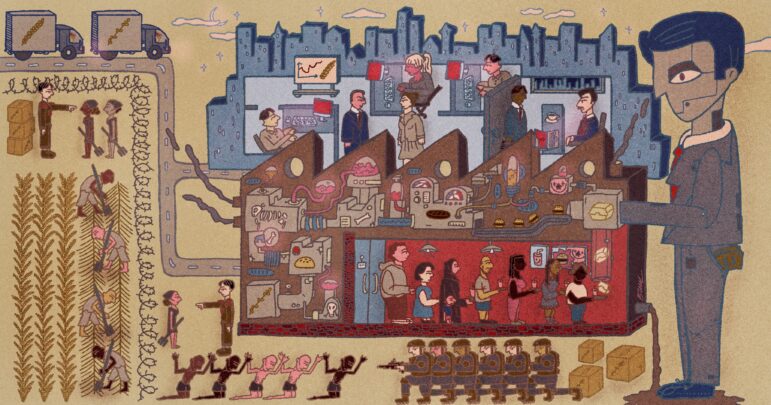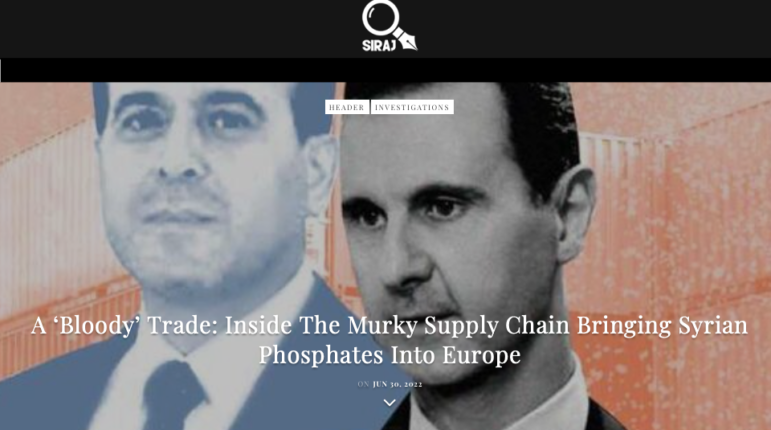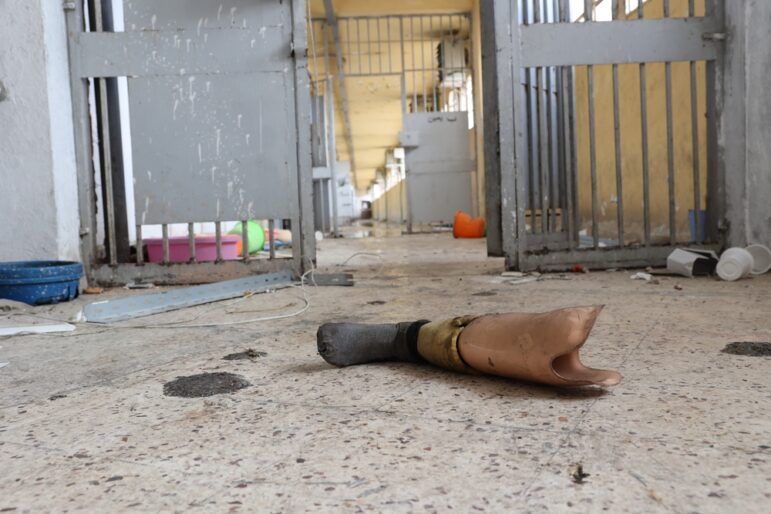

Inside Syria's notorious Sednaya prison, after the fall of the Assad regime, December 12, 2024. Image: Shutterstock
Investigating Inside Syria, Six Months After Assad’s Fall
Read this article in
When 54 years of Assad dynasty rule in Syria came to a somewhat abrupt end, after a series of armed rebel offensives culminated in the capture of Damascus on December 8, 2024, many Syrians were able to return to the country for the first time in decades.
As exiles, dissidents, journalists, and citizens celebrated being able to cross the border, Syrians also suddenly had access to the abandoned structures of Assad’s rule — from the Presidential Palace to its most feared prisons. For journalists, activists, and lawyers, it seemed like an unparalleled opportunity to conduct investigations into crimes committed during the dictatorship and civil war.
But this window for access and accountability — from both Syria’s old and new rulers — seems to be closing, according to panelists who described current realities on the ground in Syria earlier this month at the 2025 Netzwerk Recherche annual conference in Hamburg.
Amer Matar, a Syrian journalist and activist in exile in Germany since 2012 who finally returned after Assad fled to Russia, recounted seeing large rooms full of archives, heavily guarded by the rebel group HTS. When he returned to the same place a few weeks later, he found that the archives had been destroyed, often by fire. “I witnessed that in more than 15 places around Syria… we knew this would happen, so we tried to study it.”
Matar and his fellow speakers — Syrian activist and lawyer Mariana Karkoutly and Anna Osius, the Cairo bureau chief for German broadcaster ARD — were among those who traveled to Syria immediately after Assad fled to Moscow. Karkoutly and Osius joined the session, which was moderated by Kristin Becker of German public broadcaster SWR, via video link from Boston and Cairo, respectively. Matar, Karkoutly, and Osius shared their experiences, both personal and professional, in the “new” Syria, the limits to transparency imposed by the country’s new rulers, and how conducting their work in Syria has shifted in the six months since everything changed.
‘The Big Dream of My Life’
In 2011, Matar was a reporter for the pan-Arab daily Al-Hayat when he was arrested, detained, and tortured for several months for reporting on Syria’s protests. In 2022, he testified in a German court against one of his former torturers, an intelligence officer subsequently convicted of war crimes. He is also the director of the ISIS Prisons Museum, a virtual museum space and archive based on meticulous documentation — including 70,000 documents smuggled out of Syria — of crimes in Syrian prisons under ISIS. He started the project in 2017 as an attempt to trace the whereabouts of his brother, who had been kidnapped in 2013.
Matar was in Berlin when he heard Assad had fled. “That was really a big moment for me,” he recalled. “I couldn’t believe it, because that was the big dream of my life — to have Syria free from [Bashar al-Assad]… I couldn’t sleep for many days.”
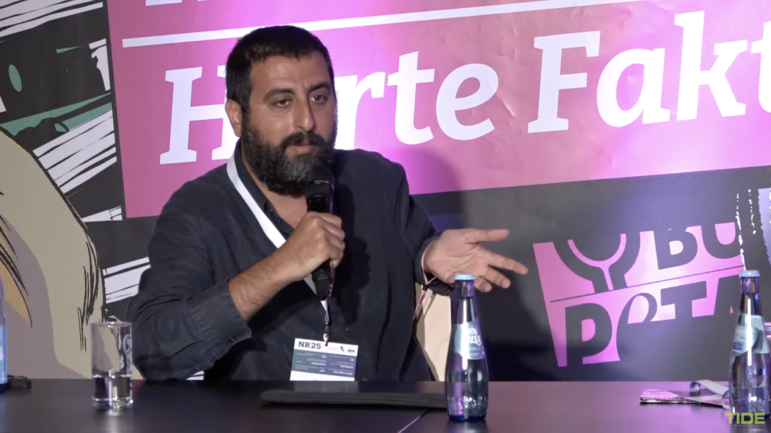
At the 2025 Netzwerk Recherche annual conference, Syrian journalist Amer Matar discusses his reporting inside Syria’s prisons since the fall of the Assad regime in late 2024. Image: TIDETVHamburg, YouTube
When Matar returned to Syria, he documented what he could of the suddenly unguarded architecture of the Assad regime prisons. He and his team spent weeks recording rooms and exteriors with special 3D cameras to create virtual models of prisons around Syria — including the notorious Sednaya military prison north of Damascus, where for decades Syrians were held, tortured, and disappeared.
Matar said they spent around one month scanning the huge, multi-floor Sednaya complex, and have been filming dozens of witnesses’ accounts there for six months. His team then matches stories with the architecture, photographs, documents, and testimonies, creating a visual map of the building and what each part was used for — in short, to “reconstruct the daily life of this prison.”
Photographs from his team’s forays inside Sednaya prison show floors covered in IDs and passports, rooms filled with discarded shoes and clothes, and relatives searching the debris for scraps of information about loved ones. Matar said that around 150,000 people are still missing today.
He explained that the online 3D tour of Sednaya prison is scheduled to go online in September 2025, and that Sednaya is one of the few prisons still empty. “The new regime decided not to save all this bad history of Syria. They want to use the horrible prisons again,” he explained. This represents a major change since his first trips to Syria. “In the first month, there wasn’t such a big focus on the new system,” he noted.
Starting out, his team had a list of 161 prisons located in Syria, and because it would take time for the 3D cameras to arrive, he began by filming inside many prisons with normal cameras because, as he puts it, “every wall is a document” — explaining that prisoners often etched their names on cell walls.
“We did that with 72 or 73 prisons around Syria. That was easy, because nobody wanted to stop you. But after that, month after month, it got harder,” he said. They are still filming in Sednaya and Tadmor prison in Palmyra, but most of the other facilities are now off-limits because they are working prisons again. “That’s really the crazy thing. We just did the Syrian revolution in 2011 to not have these horrible prisons anymore, and now we have them again, with a new system.”
He also returned to Al-Khatib prison in Damascus, one of several in which he was held in 2011 — and found that jailers there were reproducing the same methods he experienced, such as making prisoners face the wall when they opened a cell door. “I wanted to see… the cell where I was [held],” he said. “They opened the door, and there were new prisoners. That was so shocking for me… They [prisoners] are just sitting on the floor. It’s the same as when I was there in 2011. It’s the same smell, the same situation.”
‘Reproducing the Cycle of Violence’
Mariana Karkoutly has spent years pursuing accountability for human rights violations in Syria since 2011. She is an independent legal investigator with support from the Center for Justice and Accountability (CJA).
“We traveled immediately to Syria [after Assad’s fall] because there was a lot of information that we were missing for cases we were working on,” she said. “We thought, this is the time we can actually collect this documentation to finally have access to this information, and also to have access to the sites where these crimes were committed.”
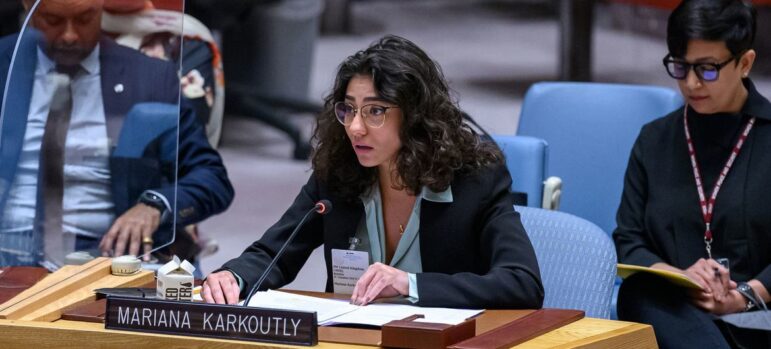
Mariana Karkoutly, seen here in a file photo briefing the UN Security Council, also joined the NR panel to discuss reporting inside Syria since the fall of the Assad regime. Image: United Nations, Loey Felipe
But, compounding the challenges of preserving documentation and the chain of custody needed for collecting evidence for war crimes cases, there is no mechanism or appetite in Syria at the moment to start such a process.
“The problem there is, within the situation at the moment — the attorney general has changed twice — we don’t have any legal framework for us to open any war crimes, crimes against humanity, or genocide cases because in Syria, those are not criminalized or prosecuted,” explained Karkoutly. “There is a lack of strategy by the attorney general, and there is a lack of transparency and access to [the interim government],” she added, adding that it has been challenging just trying to pass information, such as witness and survivors’ statements, along to the current leaders.
“The first question is: how do we reach the Syrian government? It’s absurd that we can talk to prosecution authorities and war crime units in Europe… and we cannot talk to our own attorney general. I think this is one of the biggest challenges to our work at the moment,” she said.
She said the interim government seems to have no interest in assisting investigations that could lead to justice and accountability for the Assad era, or in preserving what happened. “They are literally working against everything that Amer and his team have been doing; it’s basically moving the other way: ‘We want to look at the future, we don’t want to think about crimes that happened in the past… We want to reproduce the cycle of violence,’” she said.
Press Freedom
Anna Osius, who has reported extensively about the Middle East and Syria, said the moment they found out Assad had fallen, her team immediately started packing and headed to Beirut, then on to Lebanon’s border with Syria. “I will never forget this moment where we came to this border checkpoint, and I really had goosebumps, and there was this tough guy with a long beard standing there with many weapons, and he looked at us had a big smile and said ‘Welcome to Syria… Journalist, journalist, yes, come in, come in!”
But since her first reporting trip to the new Syria, there is now an opaque process to apply for reporting access. “We see now the shift from one regime to the other regime, definitely in terms of our work, it’s not that easy anymore to access Syria,” Osius explained. “We can still get permission… We have to apply, and sometimes it takes much longer than we expect, and we don’t know why. There’s no clear transparency — why one of us gets granted the visa within 24 hours, and the other one has to wait for several weeks.” But, she added, “international journalists are in a better situation than local journalists.”
Syrian state television has also since returned. “It’s just what we saw before, but better made,” she added. “So now we see a very modern state TV, but still they are totally in line with the government, they are following the rules, they are promoting [interim president Ahmed al-Sharaa] as the new savior of Syria. So we can see that freedom of the press is still an issue.”
While noting that there were some bleak reports in the discussion, moderator Kristin Becker gave the session an optimistic coda. Addressing the panelists, she said: “You are investigating, you are documenting, you are reporting — and as long as this is happening, I think we also have a positive note — that things are being watched, and are not just happening in the dark anymore.”
Watch the full Netzwerk Recherche panel below.
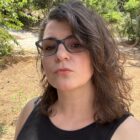 Alexa van Sickle, a GIJN associate editor, is a journalist with experience across digital and print journalism, publishing, and international think tanks and nonprofits. Before joining GIJN, she was senior editor and podcast producer for the award-winning foreign correspondence and travel magazine, Roads & Kingdoms, and a contributor for its sister site, Explore Parts Unknown — the companion website for Anthony Bourdain’s “Parts Unknown” TV show.
Alexa van Sickle, a GIJN associate editor, is a journalist with experience across digital and print journalism, publishing, and international think tanks and nonprofits. Before joining GIJN, she was senior editor and podcast producer for the award-winning foreign correspondence and travel magazine, Roads & Kingdoms, and a contributor for its sister site, Explore Parts Unknown — the companion website for Anthony Bourdain’s “Parts Unknown” TV show.



